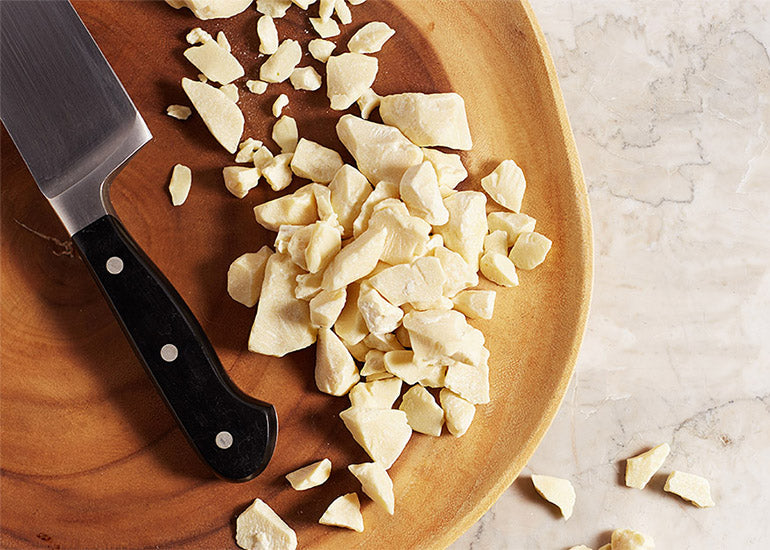There's often a bit of confusion around cacao butter, making it the most asked-about product of the Navitas Organics Cacao product line! Yet, once you become familiar with the potential of cacao butter, it's hard not to become truly enamored.
What is Cacao Butter?
Right from the start, cacao butter is a bit of a misnomer. There's no butter or dairy in cacao butter, nor is it particularly buttery in flavor. Rather, cacao butter is technically an oil. Traditionally, when making chocolate, peeled Theobroma cacao beans are crushed into cacao nibs, and then pressed and ground with very high pressure. The process of pressing cacao nibs creates two products: the dry, brown, powdery cacao "cake," otherwise known as cacao powder, and the pure cacao fat, otherwise known as cacao butter. Cacao butter looks like a golden-hued oil when melted at low heat, and hardens into a cream-colored solid when cooled to room temperature. Cacao butter is the reason why your chocolate bars are so smooth, and why the chocolate chips in cookies are hard to the touch, but melt in your mouth.
Cacao Butter vs. Cocoa Butter
Is there a difference between cacao butter and cocoa butter? In short: No. Cacao butter and cocoa butter are one and the same and both terms can be used interchangeably.
Navitas Organics Cacao Butter and all of our Cacao products are Fair Trade Certified, meaning our products are ethically sourced and meet rigorous social, environmental and economic standards. As part of our Superfoods with Purpose initiative, we've invested more than $100,000 over three years to help support the development of the Liloma Cocoa Cooperative, a young cacao co-op in Sierra Leone, where we source our cacao beans. You can learn more about our cacao bean growers here. Our cacao butter is unrefined and cold-pressed to maintain its beneficial properties, which is the same as what is sometimes marketed as "raw cacao butter."
Despite cacao butter and cocoa butter being the same, there is still a difference between cacao powder and cocoa powder. Read our article "What's the Difference Between Cocoa and Cacao?" to find out the significant differences between the two.
3 Key Cacao Butter Properties
During the chocolate making process, cacao powder and cacao butter are recombined, along with other ingredients, to better control flavor and generate a more velvety texture in the chocolate. But, to really put cacao butter to use, it's important to fully understand its three main properties:
1. Cacao butter has very little chocolate flavor.
Interestingly, cacao butter's chocolatey aroma is greater than the flavor it actually provides, which is only a hint. It serves well as a background flavor and mostly adds richness to recipes.
2. Cacao butter melts very easily over low heat.
Cacao butter is too hard to use in its solid state and must be melted before being added to a recipe to incorporate it. Luckily, this is an easy process! Simply use a chef's knife to finely chop your cacao butter and add to a small sauté pan over the lowest heat. The cacao butter will fully melt within just a couple minutes, and you should remove it as soon as the last bits of white disappear to avoid burning (cacao butter has a low smoke point). For best results, use a silicone spatula to effectively gather every last drop of the cacao butter from the pan to avoid wasting any!
3. Cacao butter will always return to its hardened state when cooled.
Just because you've melted the cacao butter, doesn't mean it will stay that way! Cacao butter will slowly re-solidify at room temperature and can be more rapidly hardened in the refrigerator or freezer. In fact, you can transform cacao butter from liquid to solid form back and forth indefinitely. Because of this hardening property, melted cacao butter needs to be thoroughly incorporated into recipes to avoid forming solid chunks or veins of hard fat, and should be added to room temperature or warmer ingredients.
Cacao Butter Health Benefits
Cacao butter is a great plant-based source of healthy fat—a vital nutrient for the health of your muscles, brain and daily functioning. Similar to coconut oil, cacao butter is a healthy fat, despite it being considered a saturated fat. Fat also helps keep you feeling full longer and makes food taste delicious!
Cacao butter is pure fat, so it does not contain any antioxidants, but when combined with antioxidant-rich cacao powder and a sweetener like maple syrup, you can create delicious superfood dark chocolate.
How Do I Use Cacao Butter?
Now for the fun part: how to use cacao butter! Cacao butter is a perfect ingredient in all kinds of dessert recipes, whether they're chocolate-themed or not. Here are four easy ways to use it:
In Baked Goods
- Use melted natural cacao butter in place of other kinds of oil, margarine or dairy butter in recipes like cookies, brownies and cakes for a subtle chocolate innuendo. For best results, use a partial substitute only, keeping in mind that cacao butter will continue to firm up the recipe a little after cooking.
In Confectioneries
- You can also use cacao butter in candies and confections like truffles, fudge and brittle with great success and, of course, make an epic homemade chocolate bar, too, by combining cacao powder with the butter and a little sweetener.
- Melted cacao butter can also be used in small amounts to blend into frostings and sweet sauces.
In Hot Drinks
- Blend cacao butter into hot drinks like lattes for an extra creamy and luxurious sipping experience.
In Beauty
- Cacao butter shares the limelight with its kin, shea butter, both revered for skincare benefits.
- Cacao butter also makes an incredible topical balm or lip balm, which can be rubbed directly onto your skin.
- For those desiring a pronounced chocolate fragrance, pure cocoa butter that is not deodorized or refined is ideal.
How Do I Store Cacao Butter?
Proper storage is crucial to maximize the benefits of cacao butter. Owing to its stability, derived from compounds like theobroma oil, it should be stored in an airtight container at room temperature, away from direct sunlight.
Natural cacao butter is an exquisite ingredient through and through. It's easy to see why this unique ingredient belongs with all your favorite superfoods!
)

